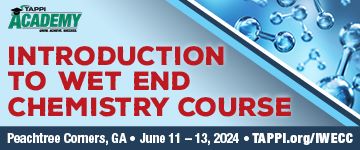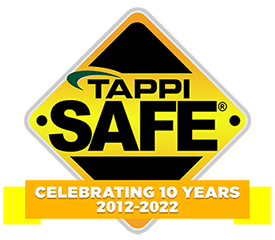 Search
Search
Use the search bar or filters below to find any TAPPI product or publication.
Filters
Content Type
Publications
Level of Knowledge
Collections
Journal articles

Magazine articles

Kraft pulp bleaching with a P-stage catalyzed by both bicarbonate and TAED, TAPPI Journal July 2019
ABSTRACT: Peroxide bleaching of softwood and hardwood (eucalypt) kraft pulps was performed in solutions of sodium bicarbonate (NaHCO3), sodium carbonate (Na2CO3), and sodium hydroxide (NaOH). The conventional P stage (hydrogen peroxide + sodium hydroxide; H2O2 + NaOH) was the most effective brightening system without an additional activator. However, peroxide activation by bicarbonate anion (HCO3•) was obvious in all cases where NaHCO3 or Na2CO3 was used. When N,N,N’,N’-tetraacetylethylenediamine (TAED) was added to the bleaching sys-tem, Na2CO3 as the alkali source afforded equal or slightly higher bleached brightness compared to NaOH usage for both the softwood and hardwood pulps. This outcome is attributed to simultaneous peroxide activation by HCO3• and TAED. When applied to the eucalypt pulp, the H2O2/Na2CO3/TAED bleaching system also decreased the bright-ness loss due to thermal reversion.
Magazine articles

English as a first and second language - part 6: avoiding grammar traps, TAPPI JOURNAL, September 1998, Vol. 81(9)
English as a first and second language - part 6: avoiding grammar traps, TAPPI JOURNAL, September 1998, Vol. 81(9)
Magazine articles

ISO 9000 registration-avoiding unnecessary procedures, TAPPI JOURNAL, November 1996, Vol. 79(11)
ISO 9000 registration-avoiding unnecessary procedures, TAPPI JOURNAL, November 1996, Vol. 79(11)
Journal articles

Magazine articles

A new method of studying the fundamental mechanisms involved in pigment liberation from recycle papers, TAPPI Journal October 2022
ABSTRACT: Deinking flotation is the most efficient and widely used method of removing ink particles from printed papers to improve the recyclability. A prerequisite for successful deinking flotation is detachment of pigments from paper fibers, a subprocess known as liberation. The degree of liberation is usually determined via hyperwashing tests, which are costly and time consuming. Furthermore, they provide no information on the fundamental mechanisms controlling liberation. In the present work, we developed a new method in which ?-potentials of the particles in a pulp are measured and analyzed. If pigments are not liberated from paper fibers, a frequency distribution plot gives a single peak, while two peaks appear when they are liberated. One can readily determine the degrees of liberation from the peak positions and peak heights. In addition, the ?-potential data can be used to construct disjoining pressure isotherms using the DLVO theory that are useful to better understand the fundamental mechanisms involved and the roles of different reagents used to improve pigment liberation.
Journal articles

Magazine articles

Using bleaching stage models for benchmarking hardwood ECF bleach plants, TAPPI Journal October 2023
ABSTRACT: Steady-state models estimated the performance of the D0(EOP)D1 bleach sequence at two mixed hardwood bleach plants in the southern United States. At Mill 1, the full sequence’s chlorine dioxide charge that brightens the pulp to ~84% ISO was monitored for two weeks. Mill 2 considered the partial sequence that brightens the pulp to ~86% ISO for nearly four weeks. Elevated levels of chlorine dioxide were linked to increased washer carryover in brownstock and extraction areas. For Mills 1 and 2, an extra 0.24% and 0.33% chlorine dioxide was consumed in the D0 stage. This extra bleach demand was equivalent to an additional 4.8 and 5.5 kappa load to the brownstock, respectively. Some differences were observed for the D1 stage. Mill 1 had extraction carryover that averaged 1.1 units higher than was measured, contributing to use of an extra 0.22% of chlorine dioxide. Mill 2 had extraction carryover that averaged between 0 and 0.7 kappa units and consumed up to 0.13% more chlorine dioxide. Another data set from Mill 2 showed high brownstock and extraction carryover, leading to ~0.90% more total chlorine dioxide usage to brighten to 84% ISO. Overall, this investigation illustrated that the models could be employed as benchmarks.
Journal articles

Magazine articles

Perfluoroalkyl and polyfluoroalkyl substances (PFAS) — Fibrous substrates, TAPPI Journal September 2023
ABSTRACT: Perfluoroalkyl and polyfluoroalkyl substances (PFAS) have been implemented during the finishing process of textiles such as upholstery, clothing, personal protective equipment, and sports gear to provide water resistance. Currently, PFAS are still present at quantifiable levels in consumer products and food, even though many companies have started to phase out PFAS treatment with non-toxic water repellant replacements given the possible detrimental health effects suggested by current research. This paper is a detailed review that focuses on how PFAS are implemented in textile production and sources of PFAS contamination during chemical treatments. This review also addresses current legislation on PFAS emissions and trade regulations to decrease exposure of consumers due to toxicokinetics and mechanisms of action through-out the body that are still not well understood. This paper includes a literature review on possible PFAS related health conditions shown from past research and contains suggested toxicity levels, exposure routes, duration, and pathways detailed to the best of our ability.
Journal articles

Magazine articles

External fibrillation of wood pulp, TAPPI Journal June 2023
ABSTRACT: Pulp refining produces external fibrillation consisting of fibrils tethered to fiber surfaces, in addition to loose fibrils and fines. Both contribute to a larger bonding area that increases paper strength, but tethered fibrils have less likelihood of being washed out during papermaking. This study postulates the mechanism by which refining produces external fibrillation and the optimum conditions for doing so.The postulated mechanism is surface abrasion during sliding of fibers in refiner gaps. External fibrillation occurs when forces are great enough to partially dislodge fibrils from fiber surfaces, but not large enough to break the fibrils. The refining intensities to achieve these forces were determined by a mathematical model and experiments using a laboratory disc refiner. The optimum intensities in terms of specific edge load (SEL) for chemical pulps were about 0.1 J/m for hardwoods and 1.0 J/m for softwoods. An extension of this study suggested that abrasion may also account for most of the energy consumed in the mechanical pulping process.
Journal articles

Magazine articles

Multifunctional starch-based barrier materials, TAPPI Journal August 2021
ABSTRACT: Natural and renewable polymer-based barrier materials play an inevitable role in a sustainable economy. Most commercially available barrier materials are either based on multiple layers of synthetic polymers or petroleum-based chemicals. Tremendous amounts of research are being done in academia and industry to replace these synthetic barrier materials with natural and environmentally friendly materials. The current work summarizes the application of starch-based materials for various barrier applications, such as water vapor, oxygen, liquid water, oil, and grease. Also, exotic starch-based barrier materials for the application of sound, ultraviolet, and thermal barrier applications are reviewed. The potential of starch-based materials to offer antimicrobial and antiviral properties is discussed. Finally, commercially available starch-based barrier materials have been summarized.
Journal articles

Magazine articles

Improving refining efficiency with deflocculation, TAPPI Journal May 2022
ABSTRACT: The ability to load a refiner requires the formation of a fiber mat between opposing refiner bars. One of the consequences of this is the formation of flocs that persist through the refiner grooves and exit the refiner. These flocs interfere with sheet strength, requiring additional energy to make up the strength deficit. In addition, flocs can initiate string formation, resulting in machine efficiency issues such as cross-machine profile deterioration and the downtime required to correct it. Novel refiner plate modifications have been shown to improve refining efficiency in otherwise identical refiner plates. Energy savings are typically around 15% of gross refining energy on the basis of the treated stock, although much higher reductions have also been seen. Addressing this previously underappreciated flaw in conventional refining enables greenhouse gas reduction and other benefits related to sheet strength and machine efficiency.
Magazine articles

A guide to developing a best management practices (bmp) plan for spent liquor, part II, TAPPI JOURNAL, December 1999, Vol. 82(12)
A guide to developing a best management practices (bmp) plan for spent liquor, part II, TAPPI JOURNAL, December 1999, Vol. 82(12)






